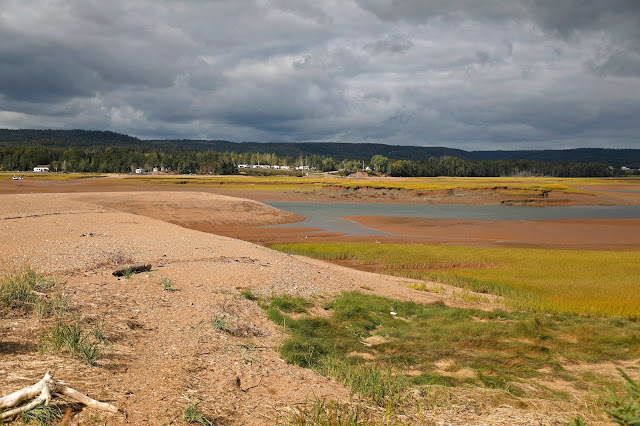Our organization did quite a bit of tree planting work in Truro this past September (2020). Truro is located in central Nova Scotia, and is often referred to as "the hub of Nova Scotia." From Truro, highways branch out in all directions to other points within the province. Truro is a small town which has an official population of only about twelve thousand people, but when you count everyone within a fifteen minute drive of the town, the number is probably closer to fifty thousand. That may not sound like much to anyone who lives elsewhere in a dense urban area. But Truro also has something else rather special. It has a municipal park, called Victoria Park. And that park is over three thousand acres in size! The people of Truro are extremely lucky to have access to such a large and beautiful park, located right inside the town limits.
But exactly how big is three thousand acres? Well, to put it into perspective, New York City's famed Central Park is less than a thousand acres. And Central Park has its own police precinct (the 22nd) which polices the 58km of pedestrian trails found there. Victoria Park also has an extensive trail network.
Here's an overview graphic of eastern Canada, showing the location of Victoria Park:
When we contacted Victoria Park to discuss the possibility of planting some trees there, we soon discovered that there were several areas which could definitely benefit. There were a few sections where trees had been removed after being killed by insects. Also, the former municipal landfill (now decommissioned) was relatively barren. Although some parts of the topsoil cap over the landfill had already been replanted several years ago by the Scouts and other organizations, there was still a great deal of work to be done.
Here's a photo of the truck and trailer, loaded and ready to go for a day of planting:
After meeting with the park forester, and taking a tour, it appeared that there could be as much as fifty to sixty acres of open ground that was suitable for afforestation efforts. The majority of that area was at the old landfill site, but there was still a significant amount of ground near the head of some of the main recreational trails. We decided to initially target most of the recreational trailhead areas in 2020, taking account of the realization that this project would obviously require a multi-year approach spread out over two or perhaps even three years.
We spent several days working on-site. For phase one, in September of 2020, we planted approximately fifteen thousand trees, which was sufficient to cover the majority of the trailhead area. Here's an overview of that section of the park. I've circled the areas that the Replant.ca Environmental organization has covered so far:
Those fifteen thousand trees reflected a fairly diverse mix, including four types of conifers (red spruce, white spruce, Jack pine, and a small number of eastern larch) plus six deciduous species (white birch, yellow birch, sugar maple, red maple, mountain ash, and red oak). Our goal was to ensure that the planted sections grow up looking like a real forest, rather than just a straight pine or spruce monoculture.
We also planted a smaller number of trees in the landfill area, although those were mostly just conifers. Here's a photo showing the location of those trees:
When we return to continue our work in the fall of 2021, our first priority will be to finish planting the remaining areas within the west side of the trailhead area. After that, we'll start to tackle the larger landfill areas (and the open patch to the north of those areas) with a similar diverse mix of at least ten or twelve different species. In addition to the species that we planted in 2020, we expect that we'll be able to add eastern white pine, eastern hemlock, and several additional new deciduous species.
Here's a photo of Dee, finishing up some survey work a day before we started planting the seedlings:
The first phase of planting on this project went very smoothly. We typically get a number of curious passersby any time we're working in any sort of a park, but the pedestrian and cyclist traffic on this project was incredible. We got to talk to dozens of people each day about the work that we were doing. We're really looking forward to going back to this project in 2021.
If you'd like to learn more about Truro's Victoria Park, visit their website:
Victoria Park is the #1 rated attraction in Truro, and has over fifteen hundred very positive reviews on Google.
Update for 2021: If you're looking for information about Phase 2 of this project, planted in 2021, visit this link:
replant-environmental.blogspot.com/2021/10/tree-planting-project-in-victoria-park.html
Thanks for reading!
Replant.ca Environmental is a Canadian company that plants trees for carbon capture and builds community forests. We also plant trees in national, provincial, and municipal public parks to mitigate damage from wildfires, storms, insects, and forest diseases. We operate thanks to numerous small contributions from the general public, in addition to larger project sponsorships from businesses and corporations around the world. If you'd like to learn how to show your support, visit our donations page. Even if you aren't able to make a contribution, we very much appreciate when people are able to share our posts or our website link on social media, to help spread the word about the work that we're doing!
To learn more about the various species that we plant, visit the conifers page or the deciduous (hardwoods) page on our website. Thanks so much for your interest!
Incidentally, our organization is often seeking additional land for our carbon capture projects. Please visit this link if you might know of a recently-harvested property that we could rebuild into a permanent legacy forest.














































